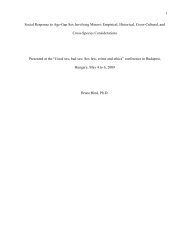Infant and Child Sexuality: A Sociological Perspective - Ipce
Infant and Child Sexuality: A Sociological Perspective - Ipce
Infant and Child Sexuality: A Sociological Perspective - Ipce
Create successful ePaper yourself
Turn your PDF publications into a flip-book with our unique Google optimized e-Paper software.
asked each boy to rate his response to each item on a list of erotic<br />
stimuli. Ramsey found a wide variation in the erotic responsiveness of<br />
each individual. The following thirteen items are arranged in a declining<br />
order based on the item’s rating as a stimulant by the group as a<br />
whole: sex conversation, female nudity, obscene pictures, motion pictures,<br />
day dreaming, burlesque or stage shows, nude art, motion when<br />
riding, literature, own body, male nudity, dancing, <strong>and</strong> music.<br />
About fifty percent of the boys reported erections resulting from<br />
some type of non-erotic stimulus, as well. The situation in which nonerotic<br />
responses occurred usually involved elements of fear, excitement<br />
or other emotional situations. The items reported as non-erotic<br />
stimuli included carnival rides, war motion pictures, being late to<br />
school, reciting before class, fast rides, playing a musical solo, b<strong>and</strong><br />
music, fear or punishment. These responses were most frequently reported<br />
for boys aged 10, 11 <strong>and</strong> 12 years.<br />
Boys also reported on dream content in which they found themselves<br />
with an erection on awakening. Dream content often contained non-erotic<br />
stimuli--fighting, accidents, wild animals, falling from high places,<br />
giants, or being chased or frightened.<br />
The incidence of masturbation among preadolescent boys of various<br />
ages is not known with precision. Ramsey (1943) summarized five personal-interview<br />
studies that, when taken along with his own study, indicate<br />
that masturbation occurs at some time in the sexual histories of<br />
nearly all males. Three-fourths reported their first experience to have<br />
been between that ages of ten <strong>and</strong> sixteen. Masturbation apparently begins<br />
for the majority of males during the years immediately preceding<br />
or very soon after puberty, for some it begins during infancy or early<br />
childhood. In Ramsey’s sample, fourteen percent of those eight year<br />
olds reported having had masturbatory experience, twenty-three percent<br />
of those nine years old, twenty-nine percent of those ten years old,<br />
fifty-four percent of those eleven years old, seventy-three percent of<br />
those twelve years old, eighty-five percent of those thirteen years<br />
old, ninety-five percent of those fourteen years old, <strong>and</strong> ninety-eight<br />
percent of those fifteen years old. The highest percentage increment<br />
came at ages 11, 12, 13, <strong>and</strong> 14 <strong>and</strong> in that order. The increment at<br />
each age from age six to age fifteen was 5.3, 4.2, 4.6, 8.8, 5.9, 24.7<br />
(age eleven), 19.1, 12.2, 10.2, <strong>and</strong> 3.1. Note the marked increment between<br />
age ten <strong>and</strong> age eleven. Boys can recall these preadolescent experiences<br />
with masturbation.<br />
I was first told about masturbation in a movie<br />
theater by one of my friends who said, “Man, I<br />
don’t know how, but I was just rubbing <strong>and</strong> all<br />
of a sudden this great thing happened to me.” It<br />
was considered the “Great, new fad.”<br />
I have masturbated since grade school. I experience<br />
very few wet dreams which I account for by<br />
the fact that I did masturbate often.<br />
Boys often learn of masturbation from each other. For girls, this<br />
is not common. Here is a case where a girl did learn from her sister,<br />
however.<br />
78
















